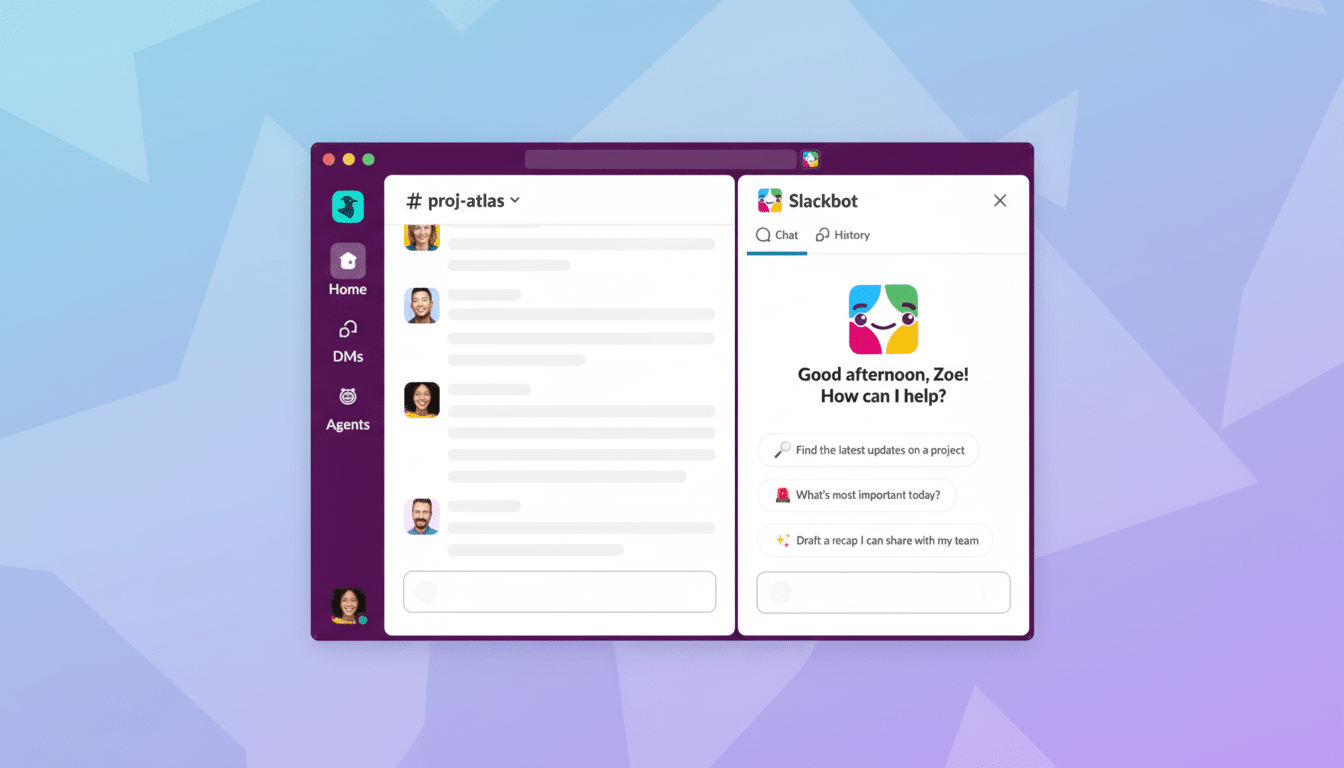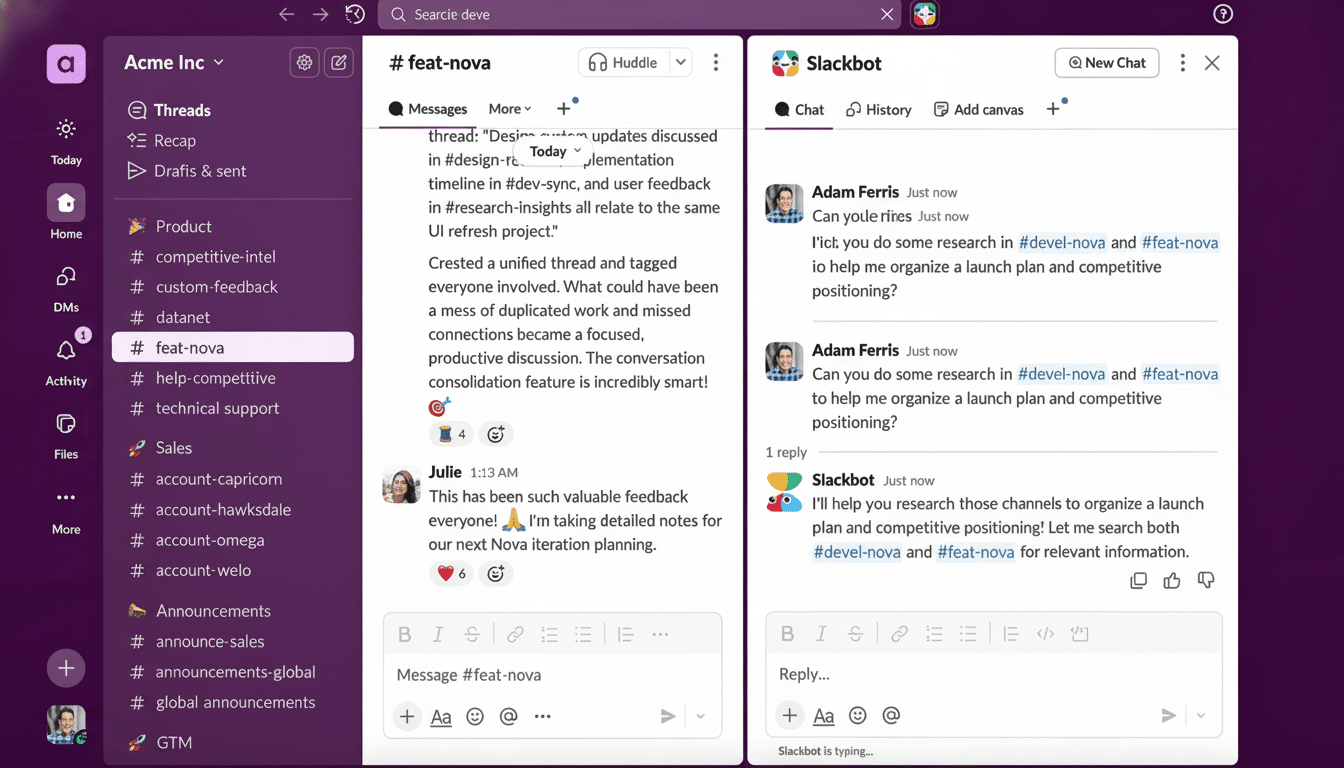Slack’s other major assistant will soon be less of a reminder system and more like a co-worker in its own right. A big AI upgrade will enable Slackbot to compose summaries across channels, draft plans in your brand’s voice and respond with specific answers to questions about ongoing work — without you slogging through a labyrinth of threads.
Slackbot AI evolves into a personalized assistant for teams
As reported by The Verge, Slack is turning Slackbot into a personalized AI assistant that’s capable of aggregating information from channels and files — even across multiple workspaces. The experience takes the form of a small icon by the search bar; click it to open up a prompt panel where requests in natural language set overarching goals for the work.

Forget “remind me at 3 p.m.” Now you can request: “Summarize the last two weeks of updates on the launch in #marketing and #product, outline the risks and draft a rollout plan.” Slackbot pulls in useful context, spits out an organized plan and matches a tone that is specifically designed to speak your brand guidelines into existence so the resulting text feels like something your team already shipped.
The assistant is intended to work with both rapid looking up (“Where’s the deck we talked about in the last sales standup?”) and multi-step knowledge work. It incorporates Slack’s newer AI capabilities — including channel recaps, thread summaries and huddle notes with action items following meetings — to create a unified view of what has taken place and what is next.
How Slackbot’s AI prompt panel works within Slack
The prompt panel from Slackbot works as a kind of lexicological co-pilot for your own little workspace, where you are the boss! You can send it to specific channels or people, filter inputs (say, by specifying “only consider messages from the past week”), and request outputs in different formats — like bullet-point summaries, stakeholder emails or task lists.
The assistant is built on retrieval-augmented generation to ground its responses in your organization’s content, reducing the risk of hallucination that hampers generic chatbots. It refers to messages, documents and summaries it is able to read and then surfaces the sources so you can click back for context.
This add-on to Slack’s nascent ecosystem of AI touch points recaps, for example, its channel-recap and translation features as well as the ability to pull other companies’ models — say, Anthropic’s Claude — into channels. The result is an assistant that exists where you work, rather than forcing teams into another app for answers.
Why team-centric AI assistance in Slack truly matters
Context switching is an invisible tax on productivity. For years, the McKinsey Global Institute has estimated that knowledge workers spend 20 percent of their time — one day a week in a five-day workweek — looking for information or colleagues who can help with specific tasks. For those responses, by bundling them into one prompt, Slackbot can cut minutes from popular tasks and speed along decision making.
Imagine a cross-functional launch: PMs want status, Marketing needs messaging, Sales requests enablement. So instead of pinging five people and re-reading three threads, a PM might ask Slackbot for a status brief with risks and owners, then for a customer-ready summary for the sales team—built on top of the latest channel activity.

For leaders, the personalized tone control is something. Teams can establish voice and style guidelines so outputs match the company’s brand, meaning draft press notes, internal memos and campaign outlines are closer to “polish and send” than “start from scratch.”
Privacy, security and admin controls for Slackbot AI
Enterprise controls remain central. Slack says its AI capabilities will observe current permissions, retention policies and admin settings. That restricts what Slackbot can deep link to, but also means that there’s no way for Slackbot to surface anything users don’t have permission to see and that organizations can specify which data is in scope for AI features at the workspace or channel level.
Slack’s security mentality features enterprise-ready controls like data loss prevention integrations and enterprise key management. Details matter, but the direction is clear: retrieval and generation are bottlenecked on the same governance that companies already apply to Slack data, augmented by some significant admin auditability.
Rollout And What To Expect In The Coming Weeks
Some 70,000 Salesforce staff are using the new Slackbot in a pilot aimed at broader testing ahead of general availability planned for the next couple of months, The Verge said. That kind of scale test internally implies Slack is tuning performance and guardrails against a broad array of use cases before loosening the reins on release.
The move brings Slack firmly into that race with Microsoft’s Copilot in Teams and Google’s AI assistants in Workspace. The wrinkle here is that Slack is tightly focused on conversation-first knowledge work, extracting the signal from unstructured threads, huddles and files to power task-level assistance.
Anticipate even tighter integration with Slack’s more recent workflow tools, like Lists for lightweight project tracking, so the assistant not only surfaces what work’s been done, but can also turn those summaries into tasks and associate them with owners and due dates—without ever leaving your channel.
If Slack pulls this off, your chatbot won’t be an answering service so much as it will become a branded operator for your organization’s knowledge base; it means turning that waterfall of chatter into decisions and plans, drafts and calendars in seconds.

